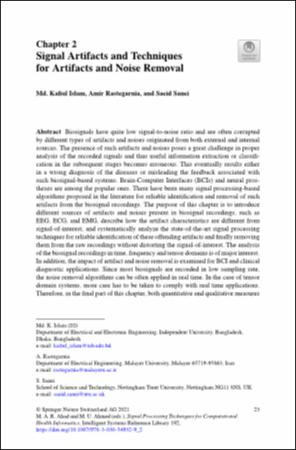| dc.contributor.author | Islam, Md. Kafiul | |
| dc.contributor.author | Rastegarnia, Amir | |
| dc.contributor.author | Sanei, Saeid | |
| dc.date.accessioned | 2020-10-08T14:40:45Z | |
| dc.date.available | 2020-10-08T14:40:45Z | |
| dc.date.issued | 2020-10-08 | |
| dc.identifier.isbn | 978-3-030-54932-9 | |
| dc.identifier.issn | 1868-4408 | |
| dc.identifier.uri | http://ar.iub.edu.bd/handle/11348/500 | |
| dc.description.abstract | Biosignals have quite low signal-to-noise ratio and are often corrupted
by different types of artifacts and noises originated from both external and internal
sources. The presence of such artifacts and noises poses a great challenge in proper
analysis of the recorded signals and thus useful information extraction or classification
in the subsequent stages becomes erroneous. This eventually results either
in a wrong diagnosis of the diseases or misleading the feedback associated with
such biosignal-based systems. Brain-Computer Interfaces (BCIs) and neural prostheses
are among the popular ones. There have been many signal processing-based
algorithms proposed in the literature for reliable identification and removal of such
artifacts from the biosignal recordings. The purpose of this chapter is to introduce
different sources of artifacts and noises present in biosignal recordings, such as
EEG, ECG, and EMG, describe how the artifact characteristics are different from
signal-of-interest, and systematically analyze the state-of-the-art signal processing
techniques for reliable identification of these offending artifacts and finally removing
them from the raw recordings without distorting the signal-of-interest. The analysis
of the biosignal recordings in time, frequency and tensor domains is of major interest.
In addition, the impact of artifact and noise removal is examined for BCI and clinical
diagnostic applications. Since most biosignals are recorded in low sampling rate,
the noise removal algorithms can be often applied in real time. In the case of tensor
domain systems, more care has to be taken to comply with real time applications.
Therefore, in the final part of this chapter, both quantitative and qualitative measures are demonstrated in tables and the algorithms are assessed in terms of their computational
complexity and cost. It is also shown that availability of some a priori clinical
or statistical information can boost the algorithm performance in many cases. | en_US |
| dc.description.sponsorship | IUB Sponsored Research Grant 2019-20 | en_US |
| dc.language.iso | en_US | en_US |
| dc.publisher | Springer | en_US |
| dc.relation.ispartofseries | Intelligent Systems Reference Library;192 | |
| dc.subject | Biosignal | en_US |
| dc.subject | artifacts | en_US |
| dc.subject | noise | en_US |
| dc.subject | signal processing techniques | en_US |
| dc.subject | EEG | en_US |
| dc.subject | ECG | en_US |
| dc.title | Signal Artifacts and Techniques for Artifacts and Noise Removal | en_US |
| dc.title.alternative | Signal Processing Techniques for Computational Health Informatics. Ahad M.A.R., Ahmed M.U. (eds) | en_US |
| dc.type | Book chapter | en_US |
